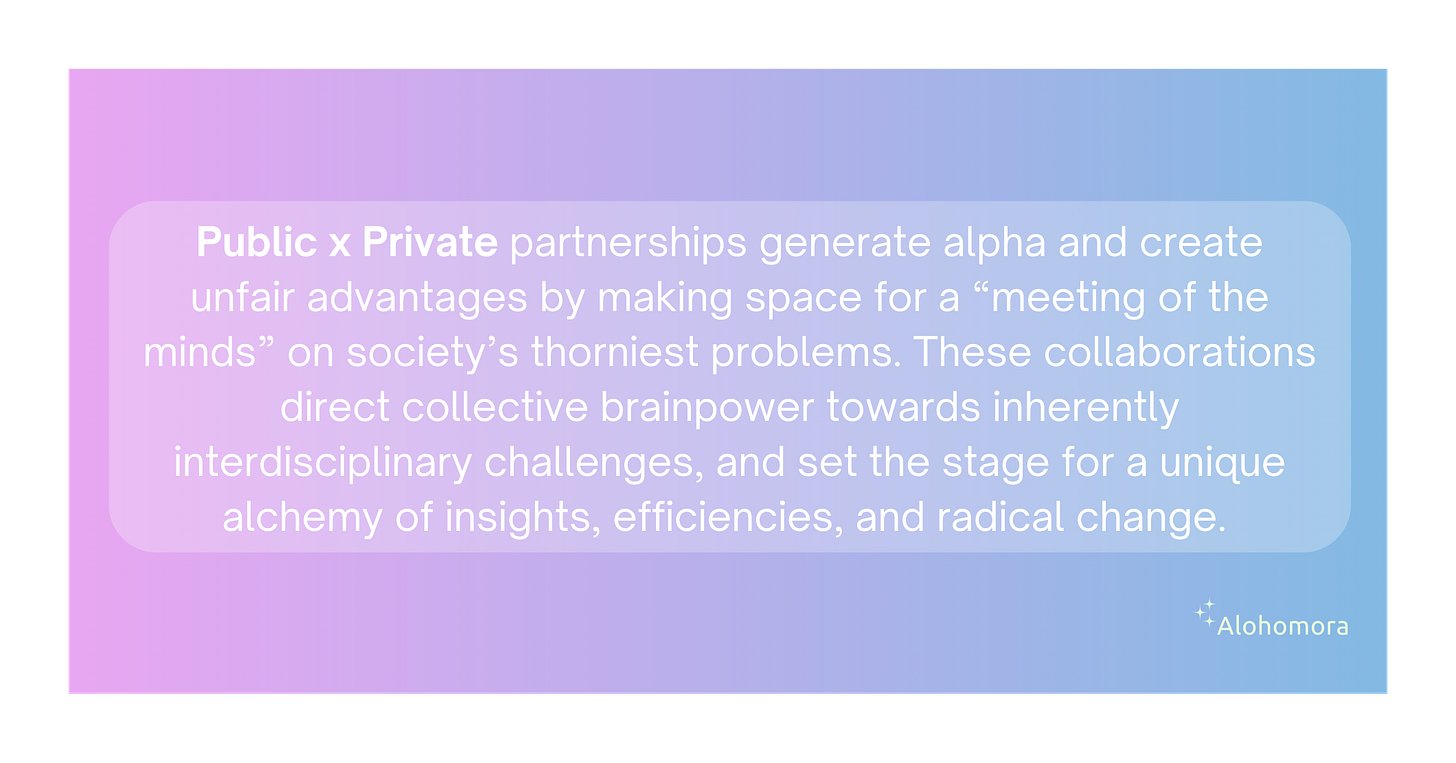The theme of this piece is partnership. In 2022, I read broadly, and felt I was learning in a Munger-like fashion:
“Munger has adopted an approach to business and life that he refers to as worldly wisdom. Munger believes that by using a range of different models from many different disciplines—psychology, history, mathematics, physics, philosophy, biology, and so on—a person can use the combined output of the synthesis to produce something that has more value than the sum of its parts.”
- Charlie Munger: The Complete Investor
This essay unwinds (a few of) today’s macroeconomic conditions, and the opportunities that unfold from the state of the world today.
After a decades-long shift towards polarization, privatization, and the relentless pursuit of shareholder profit maximization, political and social tensions have reached a fever pitch. A turning point is underfoot. For all that divides us, many Americans feel a moral imperative to make the world a better place for future generations. To be greater than the sum of our parts, we must think about partnerships.

1️⃣ Public x Private Partnership
15% of the American workforce dedicates their lives to military, public, or national service (Public Service and the Federal Government, Brookings). Many of these public sector workers protect our national security in crucial but thankless jobs. They’re the invisible force tasked with ensuring our society runs smoothly, and with the far more daunting task of keeping our country safe. These citizens are often stymied by ineffective tools and byzantine processes.
Ben Rhodes’ book After the Fall explores whether the US is in decline. If it is, in fact, in decline, what might reverse the trend? Increased service is a must - corporations and citizens that prioritize civic service create positive-sum societal benefits. Shared, service-oriented experiences give rise to a sense of belonging and purpose, a broader awareness of others’ vocations and situations, and an improved ability to reason about and ameliorate society’s big problems.
Opportunities: Ideas & Current Initiatives for Public x Private Partnership
Build communities of tomorrow. My good friend
of recently co-wrote an interesting piece about Culdesac, a startup building car-free cities. When I read it, I began thinking of military bases. Homes on military bases can suffer from recurring maintenance issues, bad water, and military families can feel isolated due to frequent moves to new bases. A company like Culdesac could be used to reimagine military bases in a climate-friendly way, with modern conveniences, community centers, and more.Build mechanisms for public sector to learn about private sector, and vice versa.
Partnership for NYC is dedicated to building public x private sector partnerships. It seeks to advance policy that affects the economic fabric of New York City, and invests in initiatives that spur innovation in NYC.
Air Force’s Education with Industry program gives Air Force members exposure to private sector by placing them with industry partners for ten months.
Increase awareness of opportunities for service to encourage participation. Provide discovery mechanisms to raise awareness of organizations and programs (nonprofits, government and private sector programs, community groups), and ensure these initiatives have the capacity (structure, leadership) to onboard and operationalize new talent.
Support people, community, and the economy.
World Business Chicago (Chicago’s economic development agency) and P33 (a nonprofit focused on building Chicago into a tech hub) partnered in January 2023 to help laid off tech workers with H-1B Visas find new jobs in Chicago. Laid off H1-B workers typically have 60 days to find a new employer willing to transfer and sponsor their visa. If they don’t find one, they may have to leave the country. Helping these people get jobs bolsters private sector, bouys the city’s tech talent pipeline, and keeps the economic flywheel spinning.
2️⃣ Scientific & Research Partnerships
A theme in both The Code Breaker and American Prometheus: The Triumph and Tragedy of J. Robert Oppenheimer is how researchers at different institutions collaborate, compete, and ultimately race towards uncovering scientific advancements that move the world forward.
In the same way academics publish seminal papers and win big awards, companies compete by building better products. Leaps in progress (like ChatGPT’s emergence as the potential future of search), springboard companies to the forefront of technology, our imaginations, and the zeitgeist, spurring competition. Collaboration (partnership) and competition fuel creativity and enable us to tackle big problems.
One of my favorite pieces of writing this year was Ark Head, by Venkatesh Rao. The piece describes an increasingly insular populace. I believe we will only be able to solve the near incomprehensible set of global problems Rao describes via partnerships. This sentiment is echoed by Choose Good Quests, authored by Trae Stephens and
, who posit people should work on things that move the world forward, rather than on squeezing every last dollar out of businesses. From Ark Head:“We increasingly respond practically to the world without even attempting to make sense of it.
One mental model for this condition is what I call ark head, as in Noah’s Ark. We’ve given up on the prospect of actually solving or managing most of the snowballing global problems and crises we’re hurtling towards. Or even meaningfully comprehending the gestalt. We’ve accepted that some large fraction of those problems will go unsolved and unmanaged, and result in a drastic but unevenly distributed reduction in quality of life for most of humanity over the next few decades. We’ve concluded that the rational response is to restrict our concerns to a small subset of local reality–an ark–and compete for a shrinking set of resources with others doing the same. We’re content to find and inhabit just one zone of positivity, large enough for ourselves and some friends. We cross our fingers and hope our little ark is outside the fallout radius of the next unmanaged crisis, whether it is a nuclear attack, aliens landing, a big hurricane, or (here in California), a big wildfire or earthquake.”
Opportunity: Supercharging the Way we Interact with Computers
Why did a 47-year-old, ~$2 trillion market cap company partner with an 8-year-old research lab focused on making AI more friendly? Microsoft, the former, employs nearly 600x more people than OpenAI, the latter. Yet, a partnership between the two gives OpenAI access to Microsoft’s supercomputing systems, Azure’s vast infrastructure, and capital. The partnership offers Microsoft the ability to refresh its entire suite of aging products with the next big thing in AI.
3️⃣ Conscientious Capitalism: Businesses with a Mission
Align business and goodness. I loved my friend Sydney’s take on MLK’s famous quote:
“The arc of the universe does not bend towards justice if nobody does the work to make it so.”
- My User Guide, Sydney Thomas
Earth is Now Our Only Shareholder is Yvon Chouinard’s (founder of Patagonia) public letter about the future of the company. In short, Patagonia created a trust (Patagonia Purpose Trust, which owns 2% of the company and all voting stock) designed to uphold its purpose, and a nonprofit (the Holdfast Collective, which owns 98% of the company, and all nonvoting stock) dedicated to fighting the environmental crisis and defending nature.
Patagonia states its purpose this way: “We’re in business to save our home planet.”
The Patagonia story is a unique one in a world where the excesses of capitalism pervade corporate actions and media narratives. I’m optimistic that more companies will pursue the Patagonia path of building great businesses - an operating modality that balances the concerns of shareholders with those of our climate, national security, employees, ethical impact, and multitude of pressing challenges that face us today.
Opportunity: A Holistic Approach to Value Creation
Per Forbes, Baby Boomers (people born between 1946 and 1964) account for 40% of small business or franchise ownership (businesses like restaurants, auto shops, plumbing businesses, retail stores, and repair shops). In a world where business owners in critical industries are reaching retirement, sometimes with no succession plan, many businesses will either shut down or be bought out.
As these older generations retire in droves, younger generations of business people are presented with an opportunity to (1) purchase and reorient existing companies towards positive business and global outcomes (2) build new, mission-oriented companies that, like Patagonia, are in the business of improving some part of our world. The big opportunity here is the possibility of new and hybrid business models that align with positive societal goals, and drive companies to consider meaning and mission alongside profit generation.
Opportunity (3) lies in building infrastructure for companies built for this new purpose-oriented paradigm.
Where do we go from here?
There is no *one* solution, but hopefully some of the opportunity spaces, initiatives, and technologies above inspire the readers of today’s post to move toward civic engagement and consider the superpowers inherent in good partnerships. We’re standing on the shoulders of giants with regard to the lattice of technology, ideas, and collaborators we can access. If we don’t build solutions, who will?
Humans aren’t the only species that manufacture dynamism through density. Bees organize into hives, ants into colonies, and microbes into living forests. In each example, the whole is greater than the sum of its parts.
- How to Maximize Creativity by David Perell
Thank you and the entire Mahlock family for providing feedback on this post!






